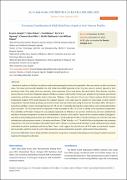| dc.contributor.author | Omujal, Francis | |
| dc.contributor.author | Ochan, Peter | |
| dc.contributor.author | Okullo, Paul | |
| dc.contributor.author | Ogwang, Patrick E | |
| dc.contributor.author | Okia, Clement Akais | |
| dc.contributor.author | Natukunda, Sheilla | |
| dc.contributor.author | Olupot, William | |
| dc.date.accessioned | 2023-01-05T09:04:45Z | |
| dc.date.available | 2023-01-05T09:04:45Z | |
| dc.date.issued | 2022-12-07 | |
| dc.identifier.citation | Omujal, F., Ochan, P., Okullo, P., Ogwang, P. E., Okia, C. A., Natukunda, S., & Olupot, W. (2022). Provisional classification of wild edible fruits based on their nutrient profiles. Acta Scientific Nutritional Health, 7(1), 39–48. https://doi.org/10.31080/ASNH.2022.06.1169 | en_US |
| dc.identifier.issn | 2582-1423 | |
| dc.identifier.uri | http://dir.muni.ac.ug/xmlui/handle/20.500.12260/485 | |
| dc.description.abstract | Nutritional analyses of food have mainly focused on determining the nutritional composition. Few concentrate on their nutritional value. This study provisionally classified ten wild edible fruits (WEF) growing in the Teso sub region in eastern Uganda by their nutritional value. Fruit pulps of Carissa spinarum, Saba comorensis, Sclerocarya birrea. Flacourtia indica, Vitex doniana, Strychnos spinosa Ximenia americana, Vangueria infausta, Vitellaria paradoxa and Physalis minima were analyzed for proximate and mineral composition, and their recommended dietary allowance (RDA) per 100g calculated. Hierarchical Cluster Analysis (HLA), Principal Components Analysis (PCA) and Canonical Discriminant Analysis (CDA) were used to classify the fruits based on their nutrient compositions. Nutrient density profiling was used to evaluate the nutritional value using the Nutrient Food Index (NFI). The HLA returned two and three clusters at linkage distances of <25 and 15 respectively, showing that these clusters were nutritionally distinct from each other. The PCA returned five components which accounted for 86.27% of the variability in the nutritional composition. The variability in Principle Component I was explained primarily by differences in moisture, total energy and total carbohydrates and that in Principle Component 2 mainly by dissimilarities in amounts of Zn and Fe. Canonical Discriminant Analysis (CDA) generated three Canonical Discriminant Functions (CDF), the first of which explained 99.2% of the total variation of the clusters with total carbohydrate and potassium content as the major contributors (Wilks’ lambda: Λ = 0.173 and 0.041 for carbohydrates and potassium respectively). The nutrient density profiles had F. indica and P. minima as the top-ranked with their overall nutritional values largely contributed by protein, potassium and dietary fibre. These results suggest that classification of WEF based on nutritional composition is possible, and these could be used in their promotion among communities in public health and nutrition education. | en_US |
| dc.language.iso | en | en_US |
| dc.publisher | Acta Scientific | en_US |
| dc.subject | Wild edible fruits | en_US |
| dc.subject | Nutrient profile | en_US |
| dc.subject | Nutritional composition | en_US |
| dc.subject | Hierarchical dendrogram clustering | en_US |
| dc.subject | Principal component analysis | en_US |
| dc.subject | Provisional classification | en_US |
| dc.title | Provisional classification of wild edible fruits based on their nutrient profiles | en_US |
| dc.type | Article | en_US |

